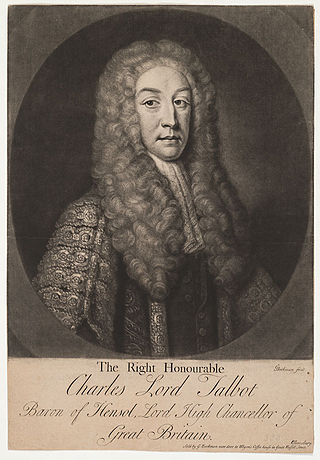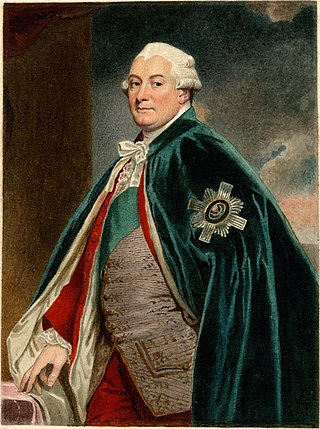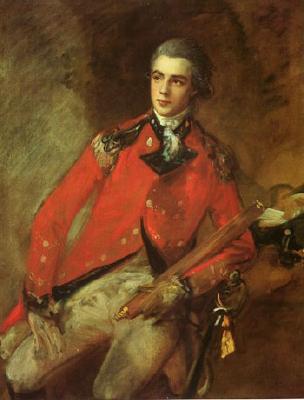
Duke of Atholl, named after Atholl in Scotland, is a title in the Peerage of Scotland held by the head of Clan Murray. It was created by Queen Anne in 1703 for John Murray, 2nd Marquess of Atholl, with a special remainder to the heir male of his father, the 1st Marquess.

Earl of Jersey, is a title in the Peerage of England. It is held by a branch of the Villiers family, which since 1819 has been the Child Villiers family.

Earl of Stair is a title in the Peerage of Scotland. It was created in 1703 for the lawyer and statesman John Dalrymple, 2nd Viscount of Stair.

Earl Talbot is a title that has been created twice in the Peerage of Great Britain. This branch of the Talbot family descends from the Hon. Sir Gilbert Talbot, third son of John Talbot, 2nd Earl of Shrewsbury. His great-great-great-grandson, the Right Reverend William Talbot, was Bishop of Oxford, of Salisbury and of Durham. His eldest son Charles Talbot was a prominent lawyer and politician. In 1733, he was raised to the Peerage of Great Britain as Lord Talbot, Baron of Hensol, in the County of Glamorgan, and then served as Lord High Chancellor of Great Britain from 1733 to 1737.

Earl Cathcart is a title in the Peerage of the United Kingdom.

Earl Granville is a title that has been created twice, once in the Peerage of Great Britain and once in the Peerage of the United Kingdom. It is now held by members of the Leveson-Gower family.

David Murray, 2nd Earl of Mansfield, 7th Viscount of Stormont, known as the (7th) Viscount of Stormont from 1748 to 1793, was a British diplomat and politician. He succeeded to both the Mansfield and Stormont lines of the Murray family, inheriting two titles and two fortunes.

General William Schaw Cathcart, 1st Earl Cathcart was a British soldier and diplomat.

Viscount of Stormont is a title in the Peerage of Scotland. It was created in 1621 by James VI for his friend and helper Sir David Murray who had saved him from the attack of the Earl of Gowrie in 1600. Murray had already been created Lord Scone, also in the Peerage of Scotland in 1605. The peerages were created with remainder to 1) Sir Mungo Murray, fourth son of John Murray, 1st Earl of Tullibardine, failing which to 2) John Murray, who was created Earl of Annandale in 1625, and failing which to 3) Sir Andrew Murray, who was created Lord Balvaird in 1641. Lord Stormont died childless and was succeeded according to the special remainder by the aforementioned Mungo Murray, the second Viscount. He died without male issue and was succeeded according to the special remainder by James Murray, 2nd Earl of Annandale, who now also became the third Viscount Stormont. He was the son of the aforementioned John Murray, 1st Earl of Annandale. He was also childless and on his death in 1658 the earldom became extinct.

David William Murray, 3rd Earl of Mansfield, KT was a British army officer and peer, who served as Lord Lieutenant of Clackmannanshire from 1803 until his death.
William David Mungo James Murray, 8th Earl of Mansfield, 7th Earl of Mansfield,, styled Lord Scone until 1970, was a British nobleman and Conservative politician.

William David Murray, 4th Earl of Mansfield, 3rd Earl of Mansfield, KT, DL was a British Conservative politician.
Lord Balvaird is a title in the Peerage of Scotland. It was created the 17th of November 1641 for Sir Andrew Murray, who was at that time also the feudal Lord of Balvaird. Before receiving that title, he was knighted by Charles the First in Scotland during his coronation in 1633. His son, the second Lord, succeeded as fourth Viscount Stormont in 1658, according to a special remainder in the letters patent.

Lady Elizabeth Mary Finch-Hatton was a British aristocrat and the subject of a notable painting, once thought to be by Johann Zoffany, now attributed to David Martin.

Mungo David Malcolm Murray, 7th Earl of Mansfield and Mansfield, styled Lord Scone from 1906 to 1935, was a Scottish Unionist Party politician.

David Murray, 1st Viscount of Stormont was a Scottish courtier, comptroller of Scotland and captain of the king's guard, known as Sir David Murray of Gospertie, then Lord Scone, and afterwards Viscount Stormont. He is known for his zeal in carrying out the ecclesiastical policy of James VI and I, in which he was effective if crude.
William Graham, 2nd Earl of Montrose was a Scottish nobleman and statesman, who successfully steered a moderate course through the treacherous waters of mid-16th century Scottish politics.
Sir Andrew Murray, 1st Lord Balvaird (1597?–1644) was a Scottish minister of Abdie in Fife, and the only minister of the Church of Scotland on whom a knighthood or peerage was conferred.
The Lordship and Barony of Balvaird is a Scottish feudal lordship. The caput of the Lordship and Barony of Balvaird is Balvaird Castle, in the County of Perthshire in Scotland. One of the borders of the Barony was at one time the River Farg. The Barony was originally granted by a Crown Charter of Confirmation in favour of Lord Andrew Murray "of the lands and Barony of Balvaird" dated 16 March 1624. The Barony is described in Latin in the crown grant as "terrarum et baronie de Balvaird". The spelling of the name of the Lordship & Barony has many variations, including Balverd, Balverde, Balward, Balwaird and Baleward.

Louisa, 2nd Countess of Mansfield, was a Scottish noblewoman, who was married twice: first to David Murray, 2nd Earl of Mansfield, and then to The Hon. Robert Fulke Greville.















